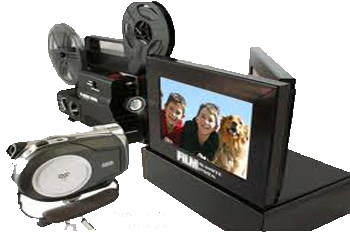
Film Conversion Equipment
Film Scanning and Film Transfer Equipment Types
The type of film scanning machine used for your 8mm, Super 8 or 16mm film conversion will have as much of an impact on the quality you receive as the resolution of the scan itself will. For example, if you wanted to digitize a photograph and tried doing it two different ways. You first put the photograph down on a table and took a picture of it using your smart phone or camera. Then you took the picture and scanned it using a flatbed scanner. If you compare the two side by side on your computer it will become really obvious that the flatbed scanner produced a digital image as good as the photograph. However, the picture you took with your phone or camera does not look close to the quality of the original photograph.
The same goes for scanning your 8mm, Super 8 or 16mm film. The real-time and frame by frame machines below are using a camcorder to take a picture of your film. The motion picture film scanner and Datacine machine are scanning the film. The results will be significantly different.
Film Conversion Equipment |
|
Real Time
|
|
Frame by Frame
|
|
Professional Film Scanners
|
|
Equally important as resolution is the type of film transfer. There are a few basic types of film transfer processes. More than 80% of the companies out there today use a real-time transfer. Any type of real-time film transfer will result in video that is 40-50% worse than the film’s current condition.
So, at this point you’ve learned that film transfers can capture at standard definition (480 lines), high definition (1080 lines) or 2K (1556 lines). You’ve also learned about the 3 different types of film transfers being used today. In order from least to best quality we have:
The film transfer processes above are the basics types and do not include any restoration by themselves. Restoration comes in many different capabilities from color and exposure correction, to grain elimination, to stabilization
Las Vegas Fun Facts: With no city or state taxes and new hotels constantly creating jobs, Las Vegas attracts young transplants seeking fortunes from its bustling economy. Las Vegas, located in southern Nevada near the Colorado River, is the largest city in the state. America's gambling capital is also its fastest-growing city (nearly doubling since the 1990s), with around 500,000 city residents and a metropolitan population of over 1,600,000. Discovered by Spanish explorers in 1829 and settled by Mormons in the 1850s, the area that would become Las Vegas developed as a stopping point for settlers on their way to California.
Nevada Fun Facts: Nevada is the seventh largest of the 50 states, but is one of the most sparsely populated. Carson City, in the western part of the state, is the capital. Gambling is legal in Nevada, and Las Vegas, the state’s largest city, is known internationally for its opulent casinos and as an entertainment destination. Nevada is also home to the Hoover Dam, which wasthe single largest public works project in the history of the United States, and Lake Mead, the largest reservoir in the country.








